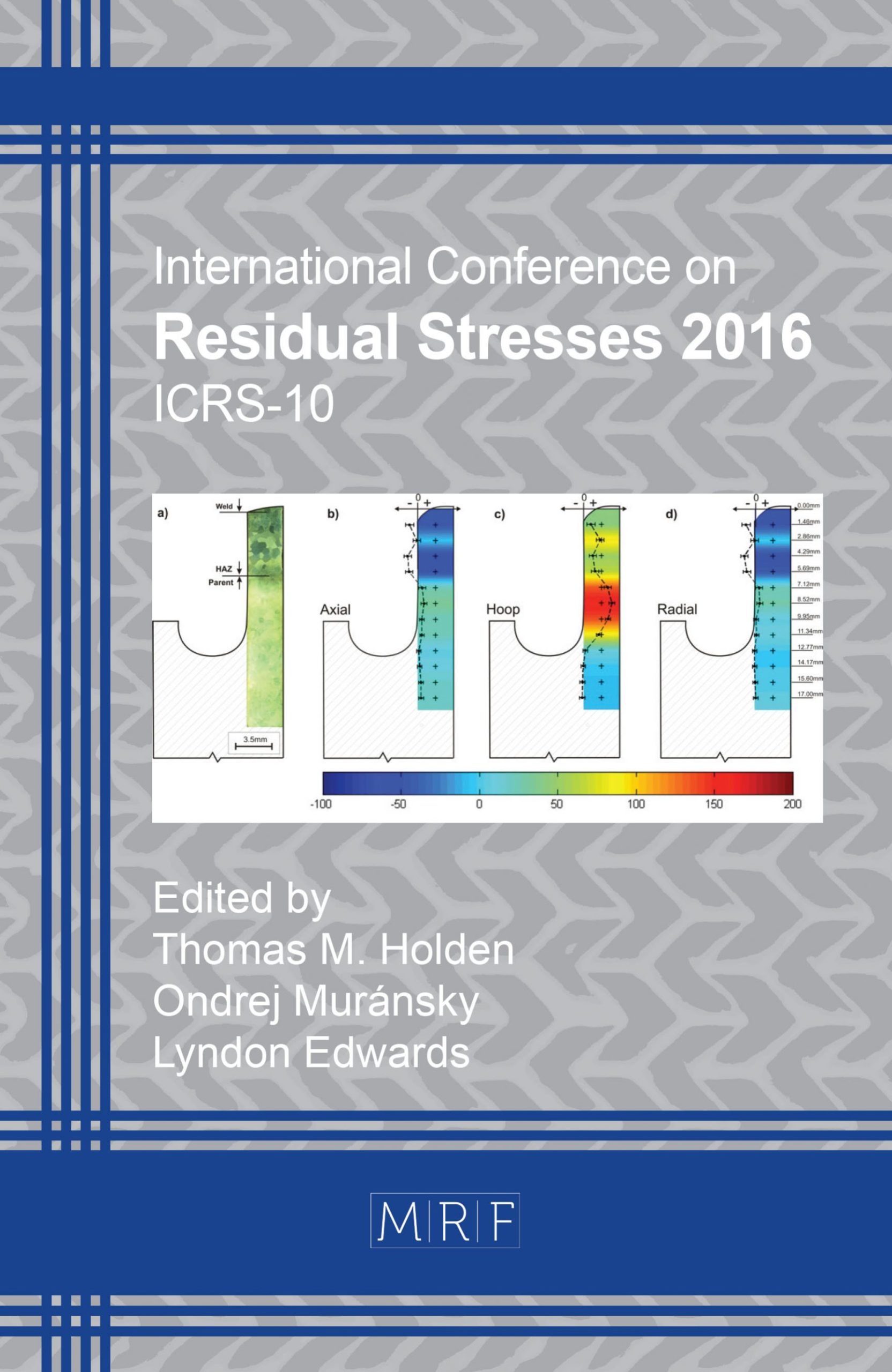Tensile Residual Stress Mitigation Using Low Temperature Phase Transformation Filler Wire in Welded Armor Plates
X. YU, D. TZELEPIS, J. BUNN, A.E. PAYZANT, Z. FENG
download PDFAbstract. Hydrogen induced cracking (HIC) has been a persistent issue in welding of high-strength steels. Mitigating residual stresses is one of the most efficient ways to control HIC. The current study develops a proactive in-process weld residual stress mitigation technique, which manipulates the thermal expansion and contraction sequence in the weldments during welding process. When the steel weld is cooled after welding, martensitic transformation will occur at a temperature below 400 °C. Volume expansion in the weld due to the martensitic transformation will reduce tensile stresses in the weld and heat affected zone and in some cases produce compressive residual stresses in the weld. Based on this concept, a customized filler wire which undergoes a martensitic phase transformation during cooling was developed. The new filler wire shows significant improvement in terms of reducing the tendency of HIC in high strength steels. Bulk residual stress mapping using neutron diffraction revealed reduced tensile and compressive residual stresses in the welds made by the new filler wire.
Keywords
Hydrogen Induced Cracking, Armor Steel, Residual Stress, Low Temperature Transformation
Published online 12/22/2016, 6 pages
Copyright © 2016 by the author(s)
Published under license by Materials Research Forum LLC., Millersville PA, USA
Citation: X. YU, D. TZELEPIS, J. BUNN, A.E. PAYZANT, Z. FENG, ‘Tensile Residual Stress Mitigation Using Low Temperature Phase Transformation Filler Wire in Welded Armor Plates’, Materials Research Proceedings, Vol. 2, pp 461-466, 2017
DOI: http://dx.doi.org/10.21741/9781945291173-78
The article was published as article 78 of the book Residual Stresses 2016
![]() Content from this work may be used under the terms of the Creative Commons Attribution 3.0 licence. Any further distribution of this work must maintain attribution to the author(s) and the title of the work, journal citation and DOI.
Content from this work may be used under the terms of the Creative Commons Attribution 3.0 licence. Any further distribution of this work must maintain attribution to the author(s) and the title of the work, journal citation and DOI.
References
[1] P. J. Withers, H. K. D. H. Bhadeshia, Residual Stress Part 1 – Measurement Techniques, Mater Sci Tech 17 (2001) 355-365. http://dx.doi.org/10.1179/026708301101509980
[2] P. J. Withers, H. K. D. H. Bhadeshia, Residual Stress Part 2 – Nature and Origins, Mater. Sci. Tech. 17 (2001) 366-375. http://dx.doi.org/10.1179/026708301101510087
[3] G. Bussu, P. E. Irving, The role of residual stress and heat affected zone properties on fatigue crack propagation in friction stir welded 2024-T351 aluminium joints, Int. J. Fatigue. 25 (2003) 77-88. http://dx.doi.org/10.1016/S0142-1123(02)00038-5
[4] G. A. Webster, A.N.Ezeilo, Residual stress distributions and their influence on fatigue lifetimes, Int J Fatigue 23 (2001) 375-383. http://dx.doi.org/10.1016/S0142-1123(01)00133-5
[5] N. Okuda, Y. Ogata, Y. Nishikawa, T. Aoki, A. Goto, T. Abe, Hydrogen-induced cracking susceptibility in high-strength weld metal, Weld. J. 66 (1987): 141s-146s.
[6] M.D. Rowe, T. W. Nelson, J. C. Lippold, Hydrogen-induced cracking along the fusion boundary of dissimilar metal welds, Weld. J. 78 (1999): 31s-37s.
[7] H.W. Lee, S. W. Kang, The relationship between residual stresses and transverse weld cracks in thick steel plate, Weld. J. 82 (2003) 225s-230s.
[8] J. L. Otegui, A. Rivas, C. Manfredi, C. Martins. Weld failures in sleeve reinforcements of pipelines. Eng. Fail. Anal. 8 (2001) 57-73. http://dx.doi.org/10.1016/S1350-6307(99)00049-7
[9] X. Cheng, J. W. Fisher, H. J. Prask, T. Gnäupel-Herold, B. T. Yen, S. Roy, Residual stress modification by post-weld treatment and its beneficial effect on fatigue strength of welded structures, Int. J. Fatigue, 25 (2003), 1259-1269. http://dx.doi.org/10.1016/j.ijfatigue.2003.08.020
[10] A. Ohta, O. Watanabe, K. Matsuoka, T. Shiga, S. Nishijima, Y. Maeda, N. Suzuki and T. Kubo, Fatigue Strength Improvement by Using Newly Developed Low Transformation Temperature Welding Material, Weld. World 43 (1999), 38–42.
[11] J. Eckerlid, T. Nilsson, L. Karlsson. Fatigue properties of longitudinal attachments welded using low transformation temperature filler. Sci. Technol. Weld. Joi. 8 (2003) 353-359. http://dx.doi.org/10.1179/136217103225005525
[12] Z. Barsoum, M. Gustafson. Spectrum fatigue of high strength steel joints welded with low temperature transformation consumables. In:2nd International Conference on Fatigue Design, Senlis, France, 2007.
[13] P. P. Darcis, H. Katsumoto, M. C. Payares-Asprino, S. Liu, T. A. Siewert. Cruciform fillet welded joint fatigue strength improvements by weld metal phase transformations. Fatigue. Fract. Eng. M. 31 (2008) 125-36. http://dx.doi.org/10.1111/j.1460-2695.2007.01205.x
[14] W. Woo, V. Em, C.R. Hubbard, H.J. Lee, K.S. Park, Residual stress determination in a dissimilar weld overlay pipe by neutron diffraction, Mat. Sci. Eng. A 528 (2011) 8021-8027 http://dx.doi.org/10.1016/j.msea.2011.07.059
[15] W. Zhang, Z. Feng, P. Crooker. Improved procedure for computing residual stresses from neutron diffraction data and its application to multipass dissimilar welds. Sci. Technol. Weld. Joi. 16 (2011) 254-260. http://dx.doi.org/10.1179/1362171810Y.0000000023































